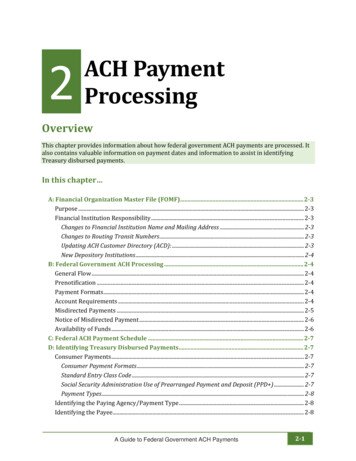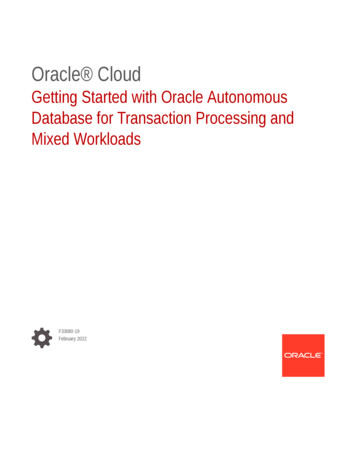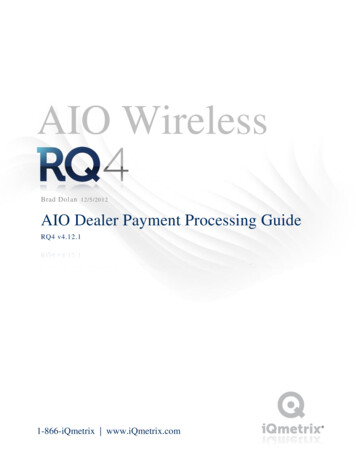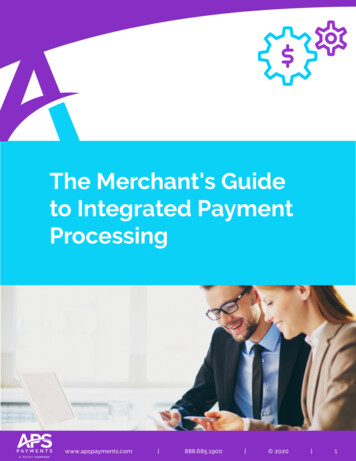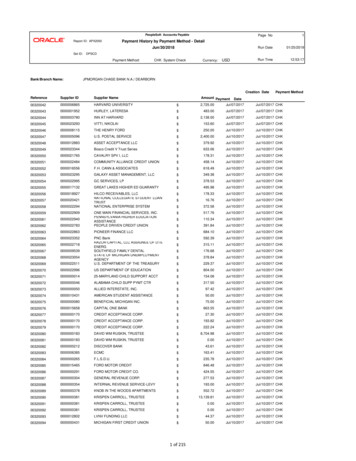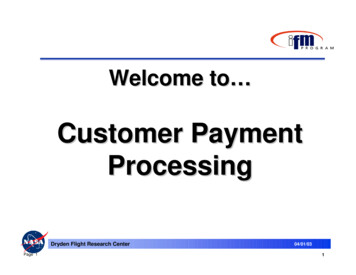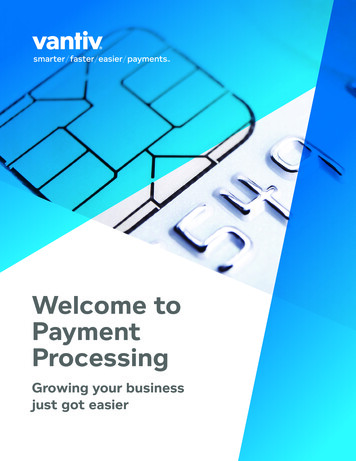
Transcription
Getting Started GuideSetting Up Your Payment Gateway Account
Getting Started GuideTable of ContentsIntroduction . 3Merchant Interface . 3Test Mode . 3Transaction Processing Settings . 4API Login ID . 5Transaction Key and Signature Key. 5Creating Your API Login ID and Transaction Key . 5Generating a New Transaction Key or a Signature Key . 5Security Settings . 6Address Verification Service . 6Card Code Verification . 7Daily Velocity Filter. 8Advanced Security . 9General Settings . 9Time Zone . 9Transaction Cut-Off Time . 10User Administration . 10Virtual Terminal. 12Help Using the Merchant Interface . 13Choosing a Connection Method . 13Maintaining Account Security . 14Card Present (CP) Merchants . 14VPOS . 14Customer Support . 15Authorize.Net Support Center. 15Contacting Customer Support . 15Last Revised: May 18, 2017 2017 Authorize.NetPage 2 of 15
Getting Started GuideIntroductionThe purpose of this guide is to provide you with the information necessary to beginprocessing transactions using your Authorize.Net Payment Gateway account. Once youhave activated your account, an Account Owner will need to log into the account toreview the default settings and make any necessary changes.This guide will introduce you to the different settings and features available with yourpayment gateway account. You should become familiar with these settings as they willhelp you submit and manage transactions, and otherwise maintain your paymentgateway account.Merchant InterfaceThe Merchant Interface is a secure website that allows you to access your paymentgateway account, manage transactions, configure account settings, view accountstatements, generate reports and more. It is available from any computer with anInternet connection and web browser—you never need to download or install anysoftware.We highly recommend you bookmark the Merchant Interface login page athttps://account.authorize.net. You can also access the Merchant Interface by visiting theAuthorize.Net home page and clicking SIGN IN, then Merchants.After you have activated your payment gateway account using the activation link fromyour welcome email, you will automatically be signed into the Merchant Interface.Test ModeOnce activation is complete, your account is automatically placed in Test Mode, which isindicated by the orange banner at the top of every Merchant Interface page. Test Modeallows you to submit test transactions for testing your connection to the paymentgateway without actually charging real transactions.Please work with your web or payment solution developer to test your connection to thepayment gateway. Once your connection is successfully tested, you may beginprocessing live transactions after switching Test Mode off. You can switch Test Mode offby clicking the orange banner.Last Revised: May 18, 2017 2017 Authorize.NetPage 3 of 15
Getting Started GuideFigure 1. Example of Merchant Interface in Test ModeYou can also switch Test Mode on at any time as a temporary safeguard in the eventthat you need to monitor suspicious activity on your account.To switch Test Mode on or off:1. Log into the Merchant Interface at https://account.authorize.net.2. Click Account from the main toolbar.3. Click Test Mode under General Security Settings.4. Drag the slider to Test or Live.Remember, you must switch Test Mode off before you can begin processing livetransactions.Transaction Processing SettingsTo connect your website or other payment application to the payment gateway, you musthave your API Login ID and Transaction Key or Signature Key. Both are unique to yourpayment gateway account and must be included with all transaction requests.Depending on your connection method, you will need to either provide this information toyour web developer, or enter it into your shopping cart or other software integration.Note: Your API Login ID and Transaction Key/Signature Key are not the same as yourMerchant Interface Login ID and password.Last Revised: May 18, 2017 2017 Authorize.NetPage 4 of 15
Getting Started GuideAPI Login IDThe Application Programming Interface (API) Login ID is used by the payment gatewayto identify you as an authorized merchant. This value is only generated once in theMerchant Interface by an Account Owner. As the API Login ID is an essential key foryour connection to the payment gateway, you will need to contact Customer Support ifyou ever need to have it reset.Transaction Key and Signature KeyThere are two types of keys available for your account: the Transaction Key and theSignature Key. Both are used by the payment gateway to authenticate that transactionssubmitted for your account are actually being submitted by you. The Transaction Key isused, along with the API Login ID, to authenticate XML and delimited requests. TheSignature Key is used to authenticate payment form requests and responses.You can generate a new Transaction or Signature Key from within the MerchantInterface at any time. As the Transaction and Signature Keys are essential keys for yourconnection to the payment gateway, you must notify your web developer or theperson that manages your payment gateway connection each time they areupdated. Otherwise your transaction processing might be interrupted.Creating Your API Login ID and Transaction Key1. Log into the Merchant Interface at https://account.authorize.net.2. Click Account from the main toolbar.3. Click API Credentials & Keys under General Security Settings.4. Enter your Secret Answer to your Secret Question in the field provided. Youshould have configured a Secret Question and Secret Answer during accountactivation.5. Click the radio button next to New Transaction Key.6. Click Submit. The API Login ID and Transaction Key generated for yourpayment gateway account will appear.Once you have initially created your API Login ID, you may not change it in the MerchantInterface. To reset your API Login ID, please contact Customer Support.Note: You cannot generate a Signature Key for your account until you have generateda Transaction Key using the instructions above.Generating a New Transaction Key or a Signature Key1. Log into the Merchant Interface at https://account.authorize.net.2. Click Account from the main toolbar.3. Click API Credentials & Keys under General Security Settings.4. Enter your Secret Answer to your Secret Question in the field provided.Last Revised: May 18, 2017 2017 Authorize.NetPage 5 of 15
Getting Started Guide5. Click the radio button next to New Transaction Key or New Signature Key.Note: If the Disable Old Transaction Key or Disable Old Signature Key checkboxes are not selected, the old keys will automatically expire in 24 hours.Disabling them immediately is helpful if you suspect your previous Keys arebeing used fraudulently.6. Click Submit. Your new key will be displayed.Be sure to store the Transaction or Signature Key in a safe place and do not share itwith anyone, as it is a sensitive piece of information.Figure 2. Example of API Credentials & Keys PageSecurity SettingsThe following are standard features of your payment gateway account, designed to helpprevent fraudulent transactions.Address Verification ServiceThe Address Verification Service (AVS) is a credit card verification system thatcompares the billing address information provided by the customer in a transaction withthe billing address on file at the customer’s credit card issuing bank. AVS then returns aresponse code indicating the results of the comparison. The payment gateway thenaccepts or rejects the transactions according to the settings you have specified.Last Revised: May 18, 2017 2017 Authorize.NetPage 6 of 15
Getting Started GuideBy default, your AVS settings are set to reject any transaction that does not have astreet address and/or ZIP code match. All international cards are also rejected bydefault.It is recommended that you review and configure your AVS settings according to yourbusiness model.To review and edit your AVS settings:1. Log into the Merchant Interface at https://account.authorize.net.2. Click Account from the main toolbar.3. Click Address Verification Service under Basic Fraud Settings.4. Check or uncheck the box next to each AVS response code depending onwhether you want to reject or accept those transactions. If you have questionsregarding the response codes, please click Help at the top right of the page toreview the help files, or review the helpful tips at the bottom of the page.Card Code VerificationCard Code Verification (CCV) is a three- or four-digit security code that is printed oncredit cards. The value appears in reverse italic at the top of the signature panel on theback of the card, or for American Express cards, on the front of the card just above theend of the credit card number.Figure 3. Credit Card CodesThese additional numbers provide an extra measure of security against unauthorizedcredit card transactions. The customer would need to have the credit card in theirpossession to know the Card Code number, as it is not stored on any system outside ofthe credit card issuer. The payment gateway allows you to customize your account sothat the system rejects transactions where the Card Code provided by the cardholder isinvalid. By using CCV, you are able to make a more informed decision about whether toaccept or reject credit card transactions.To review and edit your CCV settings:1. Log into the Merchant Interface at https://account.authorize.net.Last Revised: May 18, 2017 2017 Authorize.NetPage 7 of 15
Getting Started Guide2. Click Account from the main toolbar.3. Click Card Code Verification under Basic Fraud Settings.4. Check or uncheck the box next to each CCV response code depending onwhether you want to reject or accept those transactions. If you have questionsregarding the response codes, please click Help at the top right of the page toreview the help files.Daily Velocity FilterThe Daily Velocity Filter is a tool that allows you to specify a threshold for the number oftransactions allowed per day. All transactions exceeding the threshold in that day will beflagged and processed according to the actions you specify. This is a useful tool forpreventing high-volume attacks that are common with fraudulent transactions.To configure the Daily Velocity Filter:1. Log into the Merchant Interface at https://account.authorize.net.2. Click Account from the main toolbar.3. Click Daily Velocity under Basic Fraud Settings.4. Check the Enable Filter checkbox.5. Enter the amount of transactions you want to allow per day in the field provided.6. Click the radio button next to the action you want to take on any transactions thatexceed that amount. If you have questions regarding the actions, please clickHelp at the top right of the page to review the help files.7. Click Save.Last Revised: May 18, 2017 2017 Authorize.NetPage 8 of 15
Getting Started GuideFigure 4. Example of Daily Velocity Filter PageAdvanced SecurityIn addition to the standard payment gateway features above, Authorize.Net alsoprovides the Advanced Fraud Detection Suite (AFDS) at no additional cost. AFDS is apowerful set of customizable, rules-based filters and tools that identify, manage andprevent suspicious and potentially costly fraudulent transactions.For more information on AFDS, click Tools from the main toolbar, then click FraudDetection Suite.General SettingsThese basic settings can be used to customize your payment gateway account to yourbusiness.Time ZoneYou may configure your payment gateway account to use the time zone in which yourbusiness is located. This will allow you to properly configure your Transaction Cut-OffTime (see below) and view accurate statements and reports information.Last Revised: May 18, 2017 2017 Authorize.NetPage 9 of 15
Getting Started GuideTo review and update the Time Zone:1. Log into the Merchant Interface at https://account.authorize.net.2. Click Account from the main toolbar.3. Click Time Zone under General Information Settings.4. Select the appropriate time zone from the drop-down menu.5. Click Submit.Transaction Cut-Off TimeThis setting allows you to specify the daily cut-off time for batched transactions to bepicked up and submitted to your processor for settlement. Any transactions entered orsuccessfully authorized after the cut-off time will not be sent to the processor forsettlement until the cut-off time the following day. The default Transaction Cut-Off Timeis 3:00 PM Pacific time.To review and update the Transaction Cut-Off Time:1. Log into the Merchant Interface at https://account.authorize.net.2. Click Account from the main toolbar.3. Click Transaction Cut-Off Time under General Information Settings.4. Select the desired cut-off time using the Hour, Minute and AM/PM drop-downmenus.5. Click Submit.Changes may not take effect immediately. If transactions have already been settled forthe day, then the new Transaction Cut-Off Time will not take effect until the next day.User AdministrationThe User Administration feature allows an Account Owner to create unique useraccounts with distinct Login IDs and Passwords for employees who need access to theMerchant Interface. You can also customize permissions for each user account to matcheach employee’s individual job responsibilities—helping you to keep transaction andaccount management activities in the Merchant Interface separate and streamlining yourtransaction management processes.By default, the person who activated your payment gateway account will be an AccountOwner. This will also be the only user account until you create additional accounts.To create additional user accounts:1. Log into the Merchant Interface at https://account.authorize.net.2. Click Account from the main toolbar.3. Click User Administration from the left side menu.Last Revised: May 18, 2017 2017 Authorize.NetPage 10 of 15
Getting Started Guide4. Click Add User from the User Administration page toolbar.5. Select the type of user you would like to add from the User Role drop-downmenu. Once you select a role, the default permissions associated with that rolewill be displayed.6. You can further customize the permissions by un-checking any boxes next topermissions you do not want enabled for the user.Figure 5. Example of User PermissionsLast Revised: May 18, 2017 2017 Authorize.NetPage 11 of 15
Getting Started GuideNote: By default, Account Owners have all permissions enabled for their accountand may not be customized.7. Enter the Secret Answer to your Secret Question in the field provided at thebottom of the screen.8. Click Next to continue.9. Create a Login ID for the new user. The Login ID must be at least six (6)characters long and should contain a combination of letters and numbers.Note: Account Contacts cannot access the Merchant Interface so no Login ID isnecessary.10. Enter the user’s First Name, Last Name, Title, Phone and Email Address.11. Check the checkboxes next to each type of email notice you would like the userto receive.12. Click Submit.Once submitted, a confirmation message will appear which displays the new user’sLogin ID and temporary password. You are responsible for securely providing the userwith their temporary password. When the user logs in for the first time they will berequired to change their password.Virtual TerminalThe Virtual Terminal allows you to submit credit card or eCheck.Net transactions to thepayment gateway manually through the Merchant Interface. This feature is especiallyuseful if you accept payments for mail order/telephone order (MOTO) sales.To submit a charge transaction using the Virtual Terminal:1. Log into the Merchant Interface at https://account.authorize.net.2. Click Tools from the main toolbar.3. Select either Charge a Credit Card or Charge a Bank Account.4. Select Authorize and Capture.5. Enter customer’s payment information in the fields provided.6. Enter the amount of the transaction and enter any other customer information inthe fields provided.7. Click Submit.While a billing address is not required to process a transaction, the default AVS settingsof the account will likely decline the transaction unless a billing address is provided, orthe AVS settings have been updated.Additionally, if you are using CCV and need to enter the customer’s card code, you mayneed to configure your Virtual Terminal settings to display the card code field. You canconfigure your Virtual Terminal settings by clicking Virtual Terminal Settings at thebottom of the Virtual Terminal page.Last Revised: May 18, 2017 2017 Authorize.NetPage 12 of 15
Getting Started GuideHelp Using the Merchant InterfaceFor help with using the Merchant Interface, and for more information about settings andfeatures, please refer to the Merchant Interface Online Help Files. You can access taskspecific help files from any page in the Merchant Interface by clicking the Help linklocated in the top right of the page.Figure 6. Merchant Interface Online Help FilesChoosing a Connection MethodA connection method is a set of implementation requirements that allows you to connecta website or other application to the payment gateway for submitting transactions. If youhave not yet decided on a connection method, here are a few options to consider. Use an Authorize.Net Certified Shopping Cart or other certified solution. Contact an Authorize.Net Certified Web Developer to handle the integration foryou. If you or your someone you know have web programming skills or in-houseresources, use our flexible and customizable Application Programming Interfaces(APIs) for programming your own connection. Please visit the Authorize.NetDeveloper Center for integration guides, sample code and more.Last Revised: May 18, 2017 2017 Authorize.NetPage 13 of 15
Getting Started Guide For more information about point-of-sale and mobile payments systems that arealready integrated to the payment gateway, see our list of Certified POSSolutions. For detailed information and help deciding which connection method you shoulduse, contact your Reseller, web developer or Merchant Service Provider forassistance. The free Authorize.Net mPOS mobile application allows you to securely acceptpayments anywhere you want using an Apple iOS or Android device with yourAuthorize.Net Payment Gateway account. For more information, visithttp://www.authorize.net/mobileMaintaining Account SecurityMaintaining security for your payment gateway account is the most important way tosafeguard yourself and your customers from unauthorized transaction activity. Optimalsecurity, in some cases, can be as simple as using complex system and userpasswords, storing them safely, and changing them on a regular basis.To learn more about how you can enhance and maximize security for your account,please read the Security Best Practices White Paper ices.pdf.Card Present (CP) MerchantsIf you are a Card Present (CP) merchant, you can use your existing payment gatewayaccount to accept credit cards using our free, mobile application or the Authorize.NetVirtual Point of Sale (VPOS).VPOSVPOS turns any Internet-connected computer into a point-of-sale (POS) terminal withthe simple addition of a USB HID MagTek swipe card reader. VPOS uses your existingInternet connection, eliminating the need for additional phone lines.For more information on VPOS, including system requirements and available readers,please visit http://www.authorize.net/vpos.To access the VPOS interface, go to https://anet.vpos.authorize.net and enter yourpayment gateway Login ID and password. After entering your login information, thesystem will prompt you to install the ActiveX Control. Every time you use a newcomputer to access VPOS, you will be prompted to download the ActiveX control.The ActiveX control is safe and secure, and is designed to ensure that no one will beable to retrieve credit card data from your computer while submitting a transaction.Additionally, the ActiveX control will automatically check for VPOS updates that havebeen released, ensuring that you are using the most current VPOS version.Last Revised: May 18, 2017 2017 Authorize.NetPage 14 of 15
Getting Started GuideCustomer SupportAuthorize.Net offers several methods for helping you with any questions you may haveabout your payment gateway account, transaction processing, the Merchant Interfaceand more.Authorize.Net Support CenterThe Support Center, located at http://support.authorize.net/, is an extensive database ofanswers to the most common support-related questions. The Support Center alsoincludes a glossary and a form for submitting questions to customer support. We highlyrecommend using the Support Center for any questions you may have.Contacting Customer SupportIf you still need assistance, you can contact our Customer Support department bylogging into the Merchant Interface and clicking Contact Us at the top of the page. Fromthere you can click Live Help to chat with a support representative, or you can clickCreate a New eTicket to submit a question.Customer Support representatives can also be reached by phone 24 hours a day, 7days a week at 877-447-3938. Customer Support is closed on major holidays.Last Revised: May 18, 2017 2017 Authorize.NetPage 15 of 15
May 18, 2017 · Getting Started Guide. Introduction The purpose of this guide is to provide you with the information necessary to begin processing transactions using your Authorize.Net Payment Gateway account. Once you have activated your account, an Account Owner will need to log into the account to re
